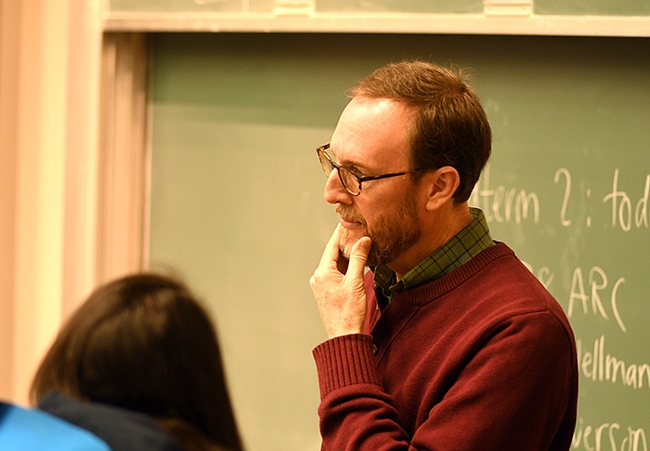- Author: Kathy Keatley Garvey

A warm welcome!
"UC Davis is a big university, with a strong focus on research," the text begins. "Undergraduates can easily feel like they are lost in the crowd, and rarely get close mentorship from faculty or other research staff (how can you, when your classes have hundreds of students present?). And yet, some of the most important skills for research biologists cannot be taught in big lecture halls or even in lab courses; these skills, especially those linked to conducting cutting-edge research are best learned through close mentoring relationships with faculty, and through an opportunity to do research (try it, make mistakes, learn from those mistakes, and get it right the next time)."
The program, co-founded and co-directed by three faculty members of the UC Davis Department of Entomology and Nematology--distinguished professor Jay Rosenheim and professors Joanna Chiu and Louie Yang--"aims to provide undergraduates with a closely-mentored research experience in biology. Because insects can be used as model systems to explore virtually any area of biology (population biology; behavior and ecology; biodiversity and evolutionary ecology; agroecology; genetics and molecular biology; biochemistry and physiology; cell biology), faculty in the program can provide research opportunities across the full sweep of biology. The program's goal is to provide academically strong and highly motivated undergraduates with a multi-year research experience that cultivates skills that will prepare them for a career in biological research."
From the depths of this innovative and excellent program, launched in 2011, come outstanding scholars--scholars like Gwen Erdosh and Gary Ge, the first two recipients of the Dr. Stephen Garczynski Undergraduate Research Scholarship. This award, sponsored by the Pacific Branch, Entomological Society of America, memorializes Stephen Garczynski (1960-2019), a research geneticist at the USDA Agricultural Research Service in Wapato, Wash.,"who had an unmatched passion for mentoring undergraduate students in their research," according to the PBESA website.
Erdosh, a research scholar in the Yang lab, won the inaugural scholarship, presented in 2022. She's continuing her research, and as @gwentomologist, is sharing her knowledge of entomology with her 77,000 followers on Instagram.
This year Ge won the undergraduate scholarship. He studies with Yang and UC Davis Distinguished Professor Art Shapiro of the Department of Evolution and Ecology, and researches the American Apollo butterfly (Parnassius clodius) as a model to study how microclimatic conditions affect cold-adapted insects. Ge is a research assistant with Shapiro's Central California Butterfly Population and Diversity Trends Study, and works with Yang as a project manager and a research assistant on his Milkweed phenology study.
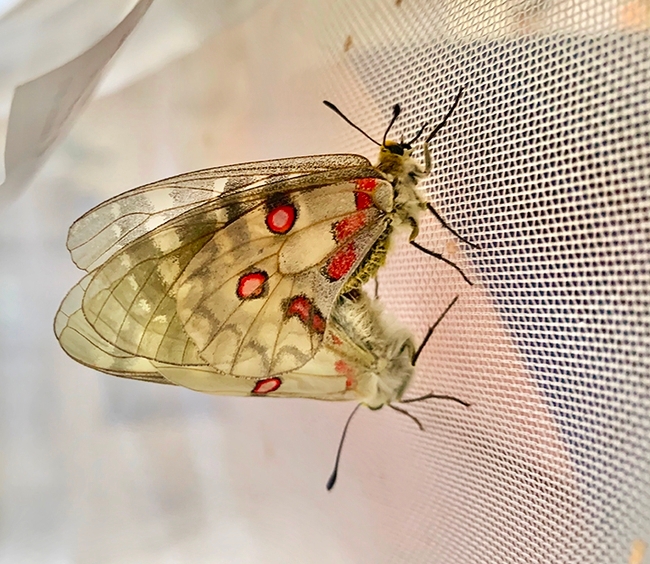
Ge will be honored at the annual PBESA meeting, April 2-5 in Seattle, which encompasses 11 Western states, plus Canada, Mexico and U.S. territories. He will receive a $1000 award for travel expenses and a waived registration fee.
Ge just finished writing a National Science Foundation's Graduate Research Fellowship Program (GRFP) grant proposal. The results are expected to be announced in April.
His hypothesis: "that mid-elevation populations of P. clodius have the best cold tolerance as overwintering eggs. The main factor behind this is snow cover. Snow cover is known to provide significant insulation to whatever is underneath, usually creating higher microclimatic temperatures under the snow than above. At mid-elevations, the winter temperatures are lower than at low elevations, and the snow cover is supposedly less and more unstable compared to higher elevations. This means the mid-elevation populations are likely exposed to the coldest winter temperature, and have locally adapted to it.”
Ge said he is testing his hypothesis “partly by looking at the supercooling points (SCPs) of diapausing eggs in different populations. The SCP indicates the freezing temperature of the egg, so it should be close to the lower lethal temperature. So, the population with the lowest average SCP would be the most cold-tolerant. I got some preliminary results recently indicating the SCP of the mid-elevation eggs is around -30 °C, which is pretty cold! On the side I am also testing the egg SCP of a Parnassius behrii population. This is a California endemic. It would be cool to see how their thermal tolerance differ from that of P. clodius as P. behrii is only found in high-elevation habitats (mostly around and above 9,000 feet).”
“The genus Parnassius is prone to global warming due to its affinity for alpine and arctic habitats, and several species are considered to be threatened," Ge said.
Shapiro, who has monitored butterfly populations across central California for the last 50 years, says that “Parnassians are a group of cold-adapted Northern Hemisphere butterflies that are becoming increasingly important as objects of physiological, ecological and evolutionary study. They are only likely to grow more important in the context of climate change. Thus, Gary's study is very timely and should attract plenty of attention! It is demanding given the rigorous conditions in which they breed and develop, and he is likely to learn a lot that will facilitate future lab and field studies.” On his research website, Art's Shapiro's Butterfly site, Shapiro describes P. clodius in detail.
Gary, born in Beijing, China, attended elementary school in New York City, middle school in Singapore, and high school in Hawaii, and now California for college. “This allowed me to have experience with a range of lepidopterans and ants and termites as well—social insects are my other favorite group.” He anticipates receiving his bachelor of science degree at UC Davis this year and hopes to enroll in graduate school at UC Davis.
Gary developed his passion for Parnassius during middle school. “When I was visiting my extended family in Tibet, I saw this small white butterfly flying through the seemingly lifeless alpine scree habitat at an elevation of around 1,5000 feet. I later found out that it was a Parnassius species and got immediately intrigued by the fact that they are mostly specialist of alpine and arctic habitats, living in some of the world's coldest and most hostile environments. Since many of the genus members have habitats restricted to mountain tops above the tree line, our P. behrii is an example, climate change--rising tree lines-would leave them nowhere to go. This makes better understanding the ecology of this genus utterly important.”
Congratulations to the scholars, their instructors, and to the UC Davis Research Scholars Program in Insect Biology. And kudos to PBESA for memorializing USDA research geneticist Stephen Garczynski and his "unmatched passion for mentoring undergraduate students in their research."
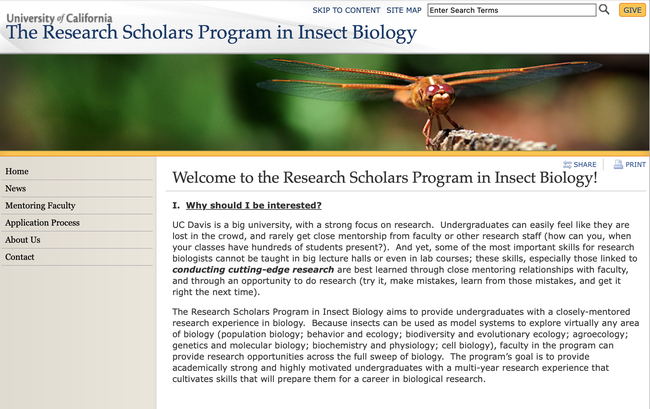
- Author: Kathy Keatley Garvey
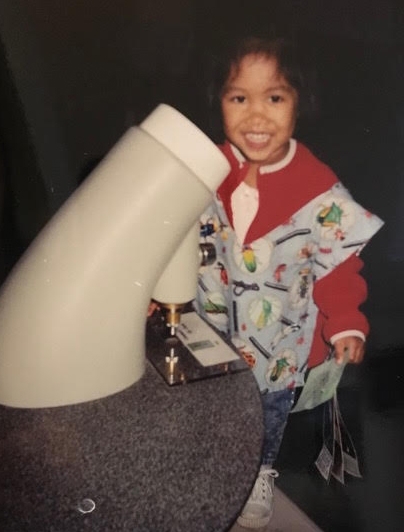
When Rebecca "RJ" Millena recently received her bachelor's degree in entomology from the University of California, Davis, it was the culmination of her kindergarten dream. At age 5, she wrote on her "About Me" poster in her Concord (Calif.) kindergarten class: "When I grow up, I want to be an entomologist."
And now she's 22 with a prized diploma in hand and an insect-themed graduation cap on her head.
The graduation cap, featuring the metamorphosis of a butterfly, is lettered with "When I grow up I want to be an entomologist."
The cap and net images are the work of Kalee Fagan, "the older sister of my best friend from high school," RJ related.
RJ's graduation cap is now entered in a UC Davis graduation cap design contest. Folks can vote for her design by simply liking this UC Davis Facebook page or making a comment by noon (Pacific Daylight Time) on June 23. The four winners receive gift cards: first-place, $300; second, $200; third, $100, and editor's choice, $100.
Her contest entry:
RJ Millena
Major: Entomology
Minors: Nematology, and Ecology, Evolution, and Biodiversity
In kindergarten, I once wrote, “When I grow up, I want to be an Entomologist.” As I graduate and continue studying insect evolution in a PhD program, I celebrate the fulfillment of my childhood dream with my cap. It features the original marker phrase from my kindergarten poster. Additionally, my first college field project involved the California pipevine swallowtail (Battus philenor)—here it represents my metamorphosis from a hopeful child to a fully-fledged entomologist.
In her dual roles as an independent student researcher in the laboratory of Jay Rosenheim, UC Davis distinguished professor of entomologist and a scholar with the Leadership Excellence through Advanced Degrees (UC LEADS) program, RJ is now finishing a research paper on Strepsiptera endoparasites, which attack their hosts, the Ammophila (thread-waisted) wasps. UC LEADS is a two-year program that prepares promising students for advanced education in science, technology, mathematics and engineering (STEM).
As part of her UC LEADS project, RJ studied specimens at the Bohart Museum of Entomology. As larvae, members of the order Strepsiptera, known as “twisted wings,” enter their hosts, including wasps and bees, through joints or sutures. In its nearly 8 million insect collection, the Bohart houses “about 30,000 specimens of Ammophila from multiple continents,” says director Lynn Kimsey, UC Davis distinguished professor of entomology. Kimsey pointed out that global wasp authority Arnold Menke (a UC Davis alumnus who studied for his 1965 doctorate with Professor Richard Bohart) identified most of them. His publication, "The Ammophila of North and Central America (Hymenoptera, Sphecidae)” is considered the bible of Ammophila research.
What's ahead? RJ has just accepted a four-year, full-ride fellowship offer to a PhD program at the American Museum of Natural History to join the systematics laboratory of Dr. Jessica Ware.
(Editor's note: RJ Millena is one of six UC Davis entomology majors who filed to graduate in the spring or summer of 2021. The others are: Maxwell Koning, Spring 2021; Laura Rivera, Summer 2021; Misa Terrell, Summer 2021; Stephanie Tsai, Spring 2021; and Elizabeth Uemura, Summer 2021)
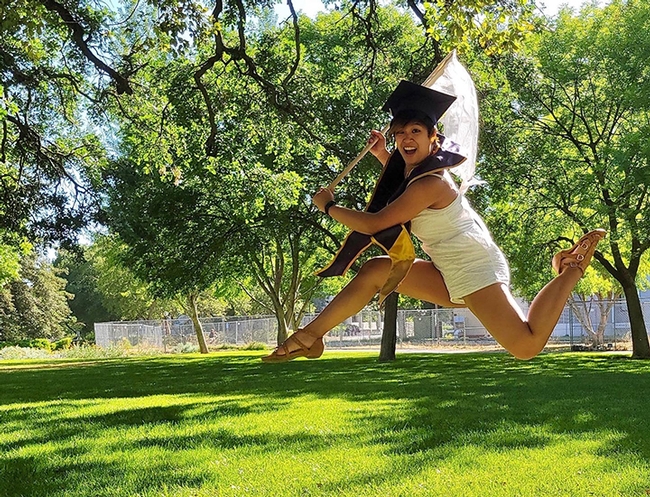
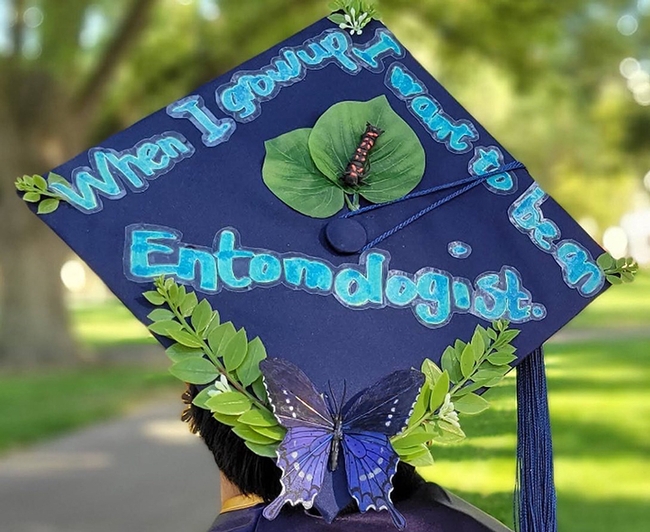
- Author: Kathy Keatley Garvey

"Ento-what?" some folks will ask. "What's that?"
Five-year-old Rebecca Jean "RJ" Millena could have told you.
She still can.
When she entered kindergarten in Concord, Calif., RJ penciled this on her "About Me" poster: "When I grow up, I want to be an entomologist."
To the amazement of her teacher and classmates, she even knew how to spell the five-syllable word referring to "the scientific study of insects."
Fast forward to today. She's 22, a senior majoring in entomology at the University of California, Davis, and an outstanding student researcher in the laboratory of UC Davis Distinguished Professor Jay Rosenheim of the Department of Entomology and Nematology.
And she's just accepted a four-year, full-ride fellowship offer to complete a doctoral program at the American Museum of Natural History. She will join the systematics laboratory of Dr. Jessica Ware after receiving her bachelor's degree from UC Davis in June.
In 2019, RJ was one of four UC Davis undergraduates selected for a two-year funded research career with the University of California Leadership Excellence through Advanced Degrees (UC LEADS) program, which prepares promising students for advanced education in science, technology, mathematics and engineering (STEM). The UC LEADS scholars embark upon a two-year program of scientific research and graduate school preparation.
Guided by Rosenheim, RJ launched her independent research project on those bizarre Strepsiptera endoparasites that attack their hosts, the Ammophila (thread-waisted) wasps.
RJ says that “being able to work with Jay on this project investigating the host-parasite relationship between Ammophila wasps and Strepsiptera was what made me fall in love with this super weird order of endoparasites." As larvae, members of the order Strepsiptera, known as “twisted wings,” enter their hosts, including wasps and bees, through joints or sutures.
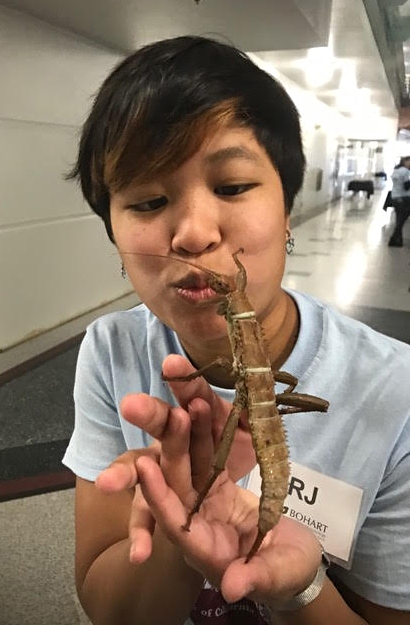
Over a two-year period, she studied thousands of specimens at the Bohart Museum of Entomology. The UC Davis insect museum houses a worldwide collection of eight million specimens, including “about 30,000 specimens of Ammophila from multiple continents,” says director Lynn Kimsey, UC Davis professor of entomology. Global wasp authority and UC Davis doctoral alumnus Arnold Menke, author of the book, The Ammophila of North and Central America (Hymenoptera, Sphecidae), identified most of the Ammophila specimens in the Bohart Museum. His book is considered "the bible" of Ammophila research.
RJ went on to enter a poster, “Parental Care and the Risk of Maternally Vectored Pathogens: Ammophila Transmit Strepsipteran Parasites to Their Young,” in the March 2021 Koret UC LEADS Symposium poster competition and won top honors.
A dean's honor student with multiple interests, RJ plays French horn and trumpet in the UC Davis Video Game Orchestra. She performed two years with the California Aggie Marching Band-Uh. In her Davis apartment she tends to a colony of Madagascar hissing cockroaches, a scorpion, a tarantula, a tailless whip scorpion, and an African cat-eye mantis. “Over the last four years at UC Davis, I've had a colony of millipedes, two other tarantulas, a giant Vietnamese centipede, and five other assorted mantis species. The five-year-old me would also be thrilled about that.”
But back to what children want to be when they grow up. Usually they say cowboy, truck driver, cook, teacher, dancer, actor, musician, artist, athlete, firefighter, detective, writer, police officer, astronaut, pilot, veterinarian, lawyer, doctor and the like.
But rarely "entomologist."
RJ's highly contagious enthusiasm toward the scientific study of insects serves as a definite role model to young girls aspiring to careers in STEM. Women make up only 28 percent of the workforce in STEM, according to the American Association of University Women. RJ is closing the gender gap.
'I Wanna Be an Entomologist'
Back in 2011, we were delighted to see UC Davis Regents Scholar Heather Wilson, a researcher/lab technician in the Frank Zalom laboratory, UC Davis Department of Entomology and Nematology, create a fun-filled, innovative video, "I Wanna Be an Entomologist," a take-off of "I Wanna Be a Billionaire" from Travie McCoy's Lazarus album.
Heather entered her project in an Entomological Society of America (ESA) contest and won honorable mention.
In her video, she runs with an insect net, counts bugs in the Zalom lab, watches bees in a hive, and visits the Bohart Museum. At the Bohart, she hugs a display of butterflies and cradles a rose-haired tarantula and Madagascar hissing cockroach from its live "petting zoo."
"I wanna be an entomologist, so freakin' bad," Wilson sings. "I wanna be on the cover of Economic Entomology, smiling next to Frank and Jim Carey..."
"Frank and Jim" are Frank Zalom and James R. Carey, UC Davis distinguished professors in the Department of Entomology and Nematology. Zalom is a past president of the 7000-member ESA, and both were selected ESA Fellows.
Watch Heather Wilson's video at https://youtu.be/rwNbbJgXNXA and you'll probably decide being an entomologist sounds much more fun than being a billionaire. Who wants to be a billionaire, anyway? Let's go check out the insects!
The entomology line forms over there...don't crowd and don't cut in.
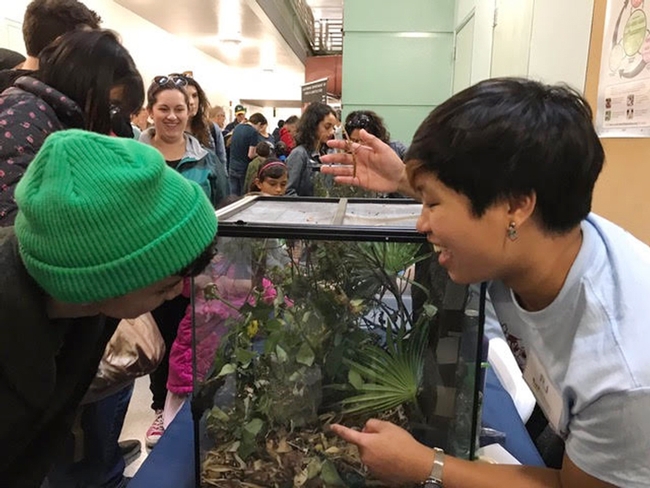
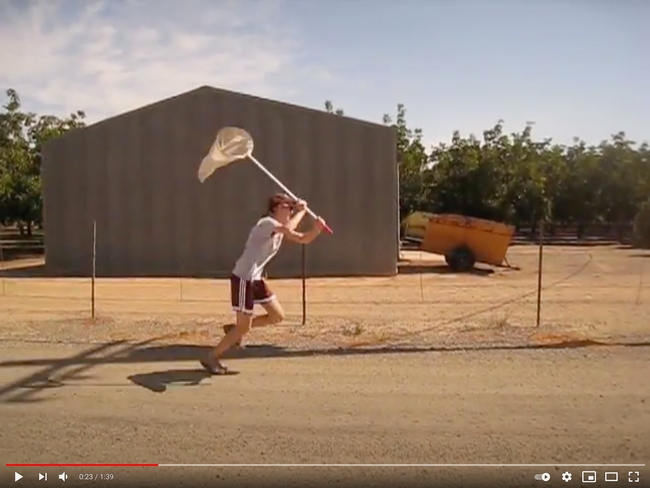
- Author: Kathy Keatley Garvey
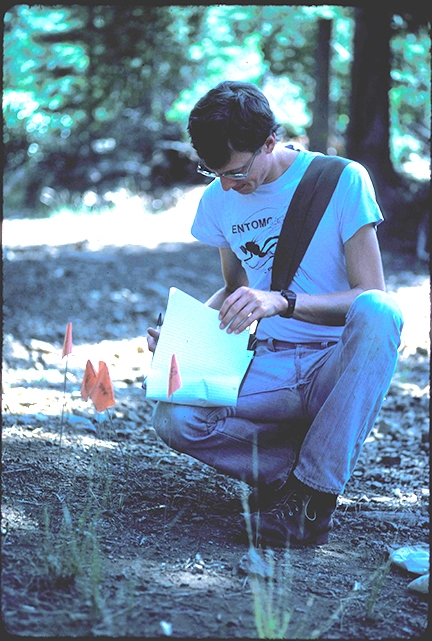
Physics? Yes.
Fortunately for the entomological world, he switched majors shortly after he enrolled in an insect science course.
As we mentioned in a piece posted on the UC Davis Department of Entomology and Nematology website, Jay was a third-year physics major in 1981 when—“on a lark”--he enrolled in Professor Harry Kaya's Entomology 100 course.
The professor inspired him, the class enthralled him, and insects captivated him.
In mid-term, Jay changed his major to entomology, and went on to earn two degrees in entomology (bachelor's degree from UC Davis in 1983, and doctorate from UC Berkeley in 1987); join the UC Davis faculty in 1990; and become a UC Davis distinguished professor in 2018.
The former UC Davis physics major is now a newly inducted Fellow of the 7000-member Entomological Society of America (ESA), a global honor accorded to only 10 persons annually.
Marshall Johnson, a 2006 ESA Fellow and an emeritus Cooperative Extension specialist and researcher at UC Riverside, nominated Rosenheim for the award. “Jay was my postdoc at the University of Hawaii,” Johnson said. “He did a great job and I have kept my eye on his career ever since."
“I would say that Jay is the most astounding entomologist that I know, given his broad interests and creative manner in studying biological/ecological questions,” Johnson said. “He is also an excellent human being.”
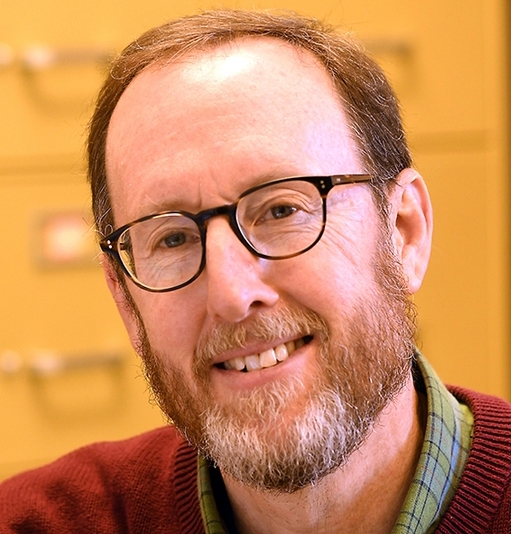
And it all began four decades ago in a UC Davis classroom. This is what occurred.
“About a month or so before the course was to be taught, I received a call from this physics student, Jay Rosenheim, who wanted to take Entomology 100,” recalled Kaya, now an emeritus professor and himself an ESA Fellow (2007) for his international contributions to insect pathology and nematology. “I asked a few questions on why he wanted to take the course. He said he always loved insects but he said he did not have the prerequisites for the class--no college biology-- but he was keenly interested in insects and really wanted to take the class.”
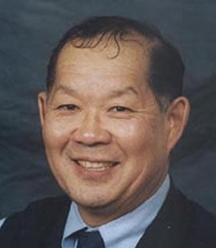
Kaya was actually teaching the class for Professor Robbin Thorp (1933-2019), a bee specialist on sabbatical. “At the time, I had a 25 percent teaching appointment in entomology and a 75 percent research appointment in nematology,” Kaya said. “When Martin Birch, the department chair, asked me to teach the course, I told him that I hoped he could find someone else, but he came back and said I would be the best to teach it.” Birch assigned two of Thorp's graduate students, Evan Sugden and John Skinner, as teaching assistants for the twice-a-week entomology lab.
“Jay also worked briefly in my lab as an undergraduate as well,” Kaya related. “I should add other superlatives as outstanding and world-renowned entomologist. In my view, it did not matter who taught the ENT 100 course. Jay is simply an outstanding individual and has contributed so much on his own merit. Plus, he has a great personality.”
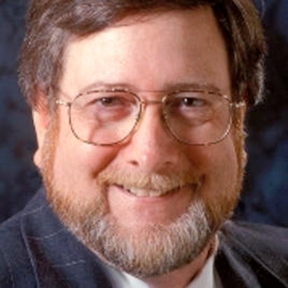
A native of Yorktown, N.Y, young Jay developed an interest in biology while exploring the vernal pools behind his Hudson River Valley home.
His insect interests not only led to his being elected an ESA Fellow but a Fellow of the American Association for the Advancement of Science; recipient of teaching awards from the Associated Students of UC Davis and the UC Davis Academic Senate; and the Distinguished Student Mentoring Award from ESA's Pacific Branch. He has authored more than 160 peer-reviewed publications, and mentored nearly 40 graduate students and postdoctoral researchers, now in the private sector, conservation nonprofits, journalism, or academia.
And it all began when a physics major named Jay Rosenheim asked to enroll in Professor Harry Kaya's entomology class.
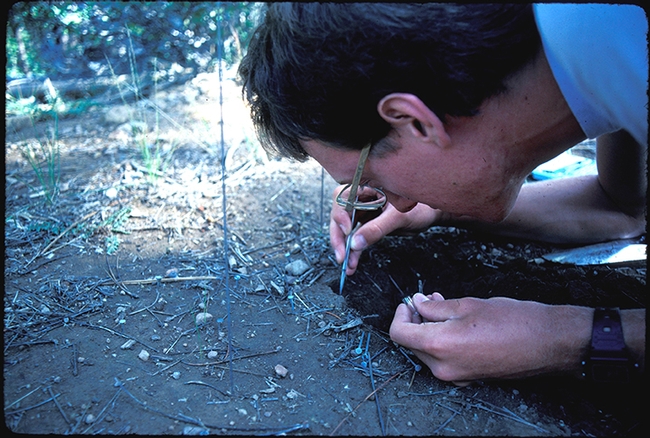

- Author: Kathy Keatley Garvey
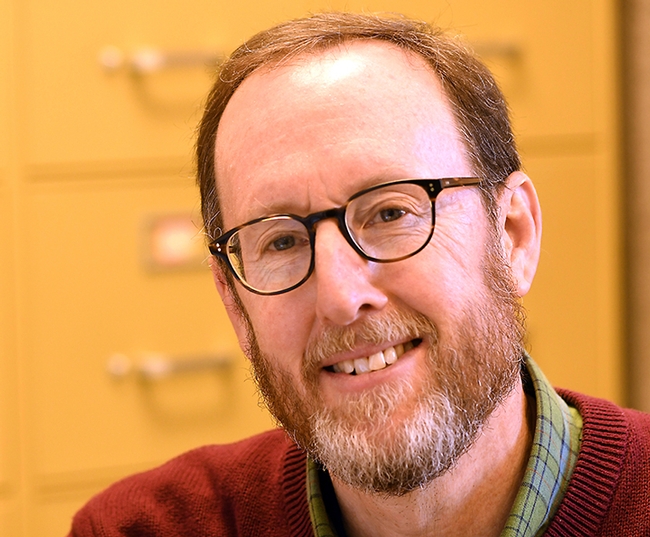
He's known for his scientific intellect, his research, his publications, his dedication, his commitment, his enthusiasm, his caring, and his kindness.
And, did we mention he's internationally known in his field?
We're delighted to see that Jay is now a newly elected Fellow of the Entomological Society of America (ESA). We wrote about him today in a piece on the UC Davis Department of Entomology and Nematology website.
Each year only 10 are selected for the honor. This year the Board of Governors selected five women and five men. They will be recognized at ESA's virtual annual meeting, Entomology 2020, Nov. 11-25.
Rosenheim, who joined the UC Davis entomology faculty in 1990, is internationally known for his research on the ecology of insect parasitoids and predators, insect reproductive behavior, and the application of big data, or "ecoinformatics," methods in agricultural entomology.
“Rosenheim's work has shown that the structure of insect communities is more complex than the archetypal model of three discretetrophic levels, under which predators eat only herbivores and herbivores eat only plants," ESA wrote in a news release. "Instead, widespread predator-predator interactions (intraguild predation), omnivory, and cannibalism create rich and diverse dynamics that can either enhance or disrupt biological control. Rosenheim has also worked to introduce big data techniques to agricultural entomology. By harnessing the decentralized data gathering efforts of farmers, field scouts, and consultants, large data sets can be created and analyzed to reveal important relationships between pests, natural enemies, and crop performance. Rosenheim's research has also examined how organisms evolve to balance multiple factors that can emerge as limits to reproductive success, and how this shapes insect and plant reproductive traits.”
Rosenheim and two other faculty members of the UC Davis Department of Entomology and Nematology--associate professors Louie Yang and Joanna Chiu-- are co-founders and co-directors of the Research Scholars Program in Insect Biology, a mentored research program for undergraduates. Founded in 2011, the program has now trained more than 100 undergraduate researchers.
I remember back in 2018 when Jay was nominated for the "Distinguished Student Mentoring Award," given by the ESA's Pacific Branch. The branch encompasses 11 states, plus U.S. territories and parts of Canada and Mexico. Rosenheim won. The praise was long and loud. Students, former students, graduate students and others lauded him. One called him "best teacher on campus--take him if you can." A former graduate student described Rosenheim as a “successful scientist with a brilliant and inquisitive mind.” Another wrote that he is “one of the most dedicated and effective teachers” he's ever encountered. The ultimate compliment: “Someday I hope to be able to teach and inspire students as well as Jay does.”
One student's comments were particularly memorable. "Since I joined his lab, Jay has been a source of inspiration, constructive feedback, and support. Jay is extremely accessible to answer questions, brainstorm ideas, and provide feedback. His kind and supportive demeanor encourages students to make us of his open-door policy."
"Before I joined the lab, Jay was already willing to read over a grant proposal, which resulted in a successful funding by the National Science Foundation's Graduate Student Fellowship. His willingness to give feedback on grant proposals and paper drafts has never waned; Jay always returns thoughtful feedback in a timely fashion. Further, Jay cultivates a laboratory atmosphere that is both collaborative and independent: Jay has never once tried to steer me in a direction I did not want to pursue with my research. Jay does not treat graduate students like employees or inferiors; he treats them as equals, as collaborators, and in doing so encourages independent, rigorous scientific thought. Because of this, I have been able to develop my own research program during my PhD."
Jay Rosenheim: great mentor, great teacher, great human being.
And now, he's achieved the well deserved honor of Fellow of the Entomological Society of America. The Department of Entomology and Nematology, the College of Agricultural and Environmental Sciences, UC Davis, and the UC system are fortunate to have him!
Congratulations, UC Davis Distinguished Professor and now ESA Fellow Jay Rosenheim!
